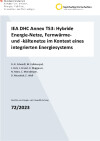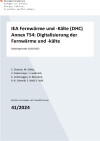Suchergebnisse
IEA DHC-Annex TS7: Industrie-DHC-Symbiose - Ein systemischer Ansatz für hochgradig integrierte industrielle und thermische Energiesysteme
Erneuerbare und überschüssige Wärmequellen machen derzeit fast ein Drittel der im DHC-Sektor verwendeten Energie aus. Überschusswärme hat das Potenzial, weiter zu einem wichtigen Teil des Energiepuzzles zu werden. Bis zu 25 % der Fernwärme und mehr als 10 % des gesamten Energiebedarfs für Heizung und Warmwasser in der EU könnte durch industrielle Abwärme gedeckt werden. Ziel dieses Tasks ist es, dieses Potenzial zu heben und die ökonomischen und organisatorischen Werkzeuge und Best-Practices aufzuzeigen.
IEA DHC Annex TS7: Industry-DHC Symbiosis - A systemic approach for highly integrated industrial and thermal energy systems
Renewable and excess heat sources are currently representing nearly a third of the energy supply used in the DHC sector. Excess heat has the potential to further grow to become an important part of the energy puzzle. Up to 25% of district heating could be covered by industrial excess heat and more than 10 % of the EU's total energy demand for heating and hot water could be covered by heat from data centres, metro stations, service sector buildings, and waste-water treatment plants.
IEA DHC Annex TS4: Digitalisation of District Heating and Cooling
The aim of the IEA DHC Annex TS4 is to identify the possibilities of digitalization and the integration of digital process for district heating and cooling. To this end, the Annex TS4 establishes a platform for industrial and scientific experts to strengthen international cooperation and networking and the exchange of experience of national research and development activities.
IEA DHC TS5 - Integration von erneuerbaren Energiequellen in bestehende Fernwärme- und Fernkältesysteme (RES DHC)
Der Ausbau nachhaltiger Fernwärme /-kälte ist ein essentieller Bestandteil der österreichischen Wärmewende. Die Transformation dieser Versorgungssysteme hin zu vollständig erneuerbaren Systemen erfordert die Kombination einer Vielzahl an Aspekten. Ziel des Projekts ist die Zusammenstellung einer Daten- und Wissensbasis aus internationalen Projekten in diesem Kontext. Expertise und Prozess-Know-how für den Ablauf der Umsetzung der Transformation der Fernwärme- und -Kältesysteme werden erfasst und aufbereitet.
IEA DHC TS5 - Integration of Renewable Energy Sources into existing District Heating and Cooling Systems (RES DHC)
The expansion of sustainable district heating/cooling is an essential part of the Austrian heat transition. The transformation of these supply systems to fully renewable systems requires the combination of a multitude of aspects. The aim of the project is to compile a data and knowledge base from international projects in this context. Expertise and process know-how for the process of implementing the transformation of district heating and cooling systems will be collected and processed.
IEA DHC Annex TS3: Hybrid Energy Networks, District Heating and Cooling Networks in an Integrated Energy System Context Guidebook
Hybrid energy networks, i.e. the integration of electricity, heat and gas networks, can make a decisive contribution to optimizing the energy system. The IEA DHC Annex TS3 analyses the potentials and challenges of hybrid energy networks from the perspective of the district heating / cooling system. This is including the analyses of relevant technologies and synergies, an assessment of the different methodological approaches and tools, the analyses of case studies as well as the development of suitable business models and regulations.
IEA DHC-Annex TS8: Erforschung von Fernwärme- und Fernkältesystemen
Dieses Projekt widmet sich der Förderung und verbesserten Nutzung von experimentellen Untersuchungen zur Transformation, Dekarbonisierung und Flexibilisierung neuer und bestehender Fernwärme- und Fernkältesysteme. Ein starker Fokus wird auf die Einbindung digitaler Technologien gesetzt, sowohl hinsichtlich der Fragestellungen (z.B. Internet of Things- und Cloud-Lösungen, digitale Zwillinge, Machine Learning) als auch der experimentellen Durchführung (z.B. Hardware-in-the-Loop, Data Spaces).
IEA DHC Annex TS8: Experimental investigations of DHC systems
The project aims at promoting and improving the use of experimental studies for the transformation, decarbonization and flexibilization of new and existing district heating and cooling (DHC) systems. A strong focus will be on the integration of digital technologies, both in terms of application (e.g., IoT and cloud solutions, digital twins, machine learning) and experimental implementation (e.g., hardware-in-the-loop, data spaces).
IEA DHC Annex TS9: Digitalisierung von Fernwärme- und Fernkältesystemen (Arbeitsperiode 2024 - 2028)
Die erfolgreiche Digitalisierung im Bereich Fernwärme und -kälte (FWK) setzt ein Bewusstsein für die Vorteile der Integration digitaler Prozesse in FWK-Netzen voraus. Dieses Projekt widmet sich daher der Untersuchung der Kommunikation und Verarbeitung von Daten zwischen den beteiligten Komponenten in FWK-Netzen, mit Fokus auf Interoperabilität und Standardisierung. Weiters erfolgt eine Evaluierung nicht-technischer Barrieren und Enabler für Digitalisierungsprozesse im FWK-Bereich.
IEA DHC Annex TS9: Digitalisation of District Heating and Cooling – Improving Efficiency and Performance Through Data Integration (Working period 2024 - 2028)
To successfully digitalize district heating and cooling (DHC), it is important to understand the benefits of incorporating digital processes into DHC networks. The purpose of this project is to investigate solutions for data transfer and processing between the components of DHC networks, with a focus on interoperability and standardization. Furthermore, non-technical hurdles and enablers to digitization processes in the DHC sector are assessed.
Visualisierungen der Technologiekooperationsprogramme der IEA 2020
Im Rahmen der Forschungskooperation der IEA findet eine weltweite Zusammenarbeit für die Energieversorgung der Zukunft statt. Auf einer Graphen-Datenbank basierende Visualisierungen zeigen die umfangreichen Aktivitäten der einzelnen Technologiekooperationsprogramme (TCPs) auf. Die Kooperationen der Staaten zu einzelnen Themen werden so ebenfalls gut sichtbar.
IEA DHC Annex TS3: Hybride Energie-Netze, Fernwärme- und -kältenetze im Kontext eines integrierten Energiesystems

Hybride Energienetze, also die Integration von Strom-, Wärme- und Gasnetzen können zur Optimierung des Energiesystems entscheidend beitragen. Der IEA DHC Annex TS3 analysiert Potentiale und Herausforderungen hybrider Energienetze aus Sicht des Fernwärme/Kälte-Systems. Dieses inkludiert die Analyse von Technologien und Synergien, die Bewertung von Tools und Methoden, die Analyse von Fallbeispielen sowie die Entwicklung geeigneter Geschäftsmodelle und Rahmenbedingungen.
Schriftenreihe
72/2023
R.-R. Schmidt, M. Fallahnejad, J. Kelz, L. Kranzl, K. Maggauer, N. Marx, C. Monsberger, D. Muschick, E. Widl
Herausgeber: BMK
Deutsch, 54 Seiten
Downloads zur Publikation
IEA Fernwärme und -Kälte (DHC) Annex TS4: Digitalisierung der Fernwärme und -kälte

Im Rahmen des IEA DHC Annex TS4 wurden die Möglichkeiten der Digitalisierung von Fernwärme- und Fernkälte-Systemen identifiziert sowie die Integration digitaler Prozesse analysiert. Dazu bildet der Annex TS4 eine Plattform für Expert:innen aus Wissenschaft und Industrie zur Stärkung der internationalen Forschungszusammenarbeit und zur Vernetzung von Wissen aus den jeweiligen nationalen Forschungsaktivitäten.
Schriftenreihe
41/2024
C. Deutsch, M. Gölles, V. Kaisermayer, I. Leusbrock, K. Lichtenegger, D. Muschick, R.-R. Schmidt, E. Widl, V. Wilk
Herausgeber: BMK
Deutsch, 62 Seiten
Downloads zur Publikation
IEA DHC: The district heating business model 2050

Report bzgl. der für die Umgestaltung des Fernwärmesystems notwendigen Geschäfts- und Finanzierungsmodelle im Jahr 2050
Lygnerud K, Kortegaard-StØchel H, Popovic T, Schultze S, Salomonsen P, Rosebrock O, Riba J.
Herausgeber: IEA DHC, 2023
Englisch, 98 Seiten
IEA DHC: Projektbericht - Leave second generation behind: Cost-effective solutions for small to large scale DH networks

Abschlussbericht des Projektes “Leave second generation behind”, mit einem Fokus auf der Entwicklung von kosteneffizienten Lösungen zur Senkung der Vorlauftemperatur für unterschiedliche Netzgrößen.
Guelpa E, Capone M, Vasset N, Sciacovelli, P. Niknam, Merlet Y, Baviere R, and Verda V.
Herausgeber: IEA DHC, 2023
Englisch
IEA DHC TCP Broschüre: IEA Technology Collaboration Programme on District Heating and Cooling (2021)

A brochure to get a brief overview over the IEA DHC programme
Herausgeber: IEA DHC c/o AGFW Projekt GmbH; 2021
Englisch, 12 Seiten
Downloads zur Publikation
IEA DHC: Final Report - Optimized transition towards low-temperature and low-carbon DH systems (OPTiTRANS)

Bericht über die Überwindung von praktischen Hindernissen bei der Entwicklung von Fernwärmenetzen zu Niedertemperatursystemen.
Rämä M., Abdurafikov R., Pursiheimo E., Svendsen S., Tunzi M., Sandvall A., Romanchenko D., Salenbien R.
Herausgeber: IEA DHC Annex XIII, 2023
Englisch, 133 Seiten
IEA Fernwärme und -Kälte (DHC TCP)
Das TCP zu Fernwärme und –Kälte wurde 1983 gegründet. Es beschäftigt sich mit der Auslegung, Leistungsfähigkeit und dem Betrieb von FWK und Kraft-Wärme-Kopplungs-Systemen als leistungsstarke Tools für Energieeinsparungen und die Reduktion der Umweltbelastungen der Wärmeversorgung.
IEA District Heating and Cooling (DHC TCP)
The TCP on District Heating and Cooling (DHC) was founded in 1983. It deals with the design, performance and operation of DHC and Combined Heat and Power systems as powerful tools for energy conservation and the reduction of environmental impacts of supplying heat.
Mapping of IEA TCPs
Ziel des Projekts war, aktuelle Aktivitäten des IEA Energie Technologienetzwerks zu visualisieren und mögliche Lücken und Überschneidungen zu identifizieren. Das Mapping beinhaltet 185 laufende Tasks und Annexe (Stand September 2017).
